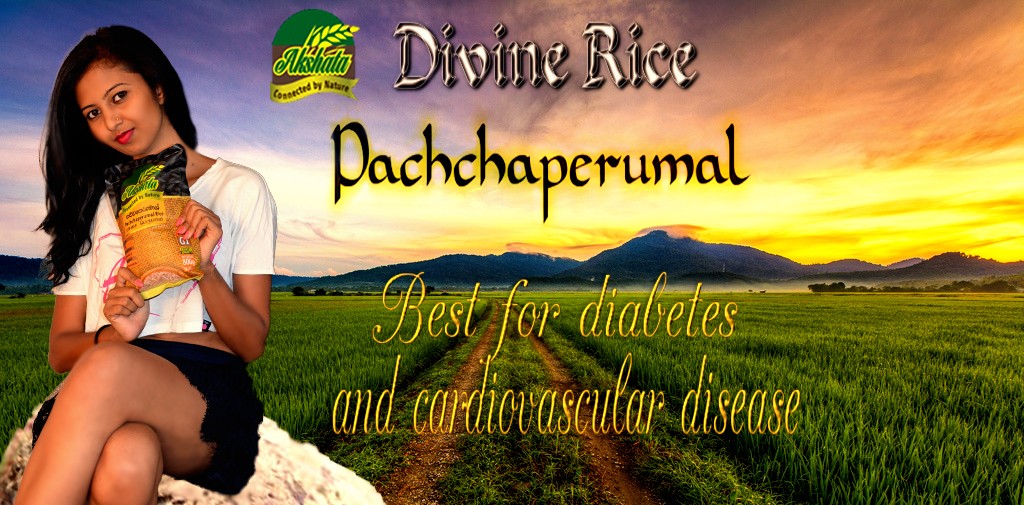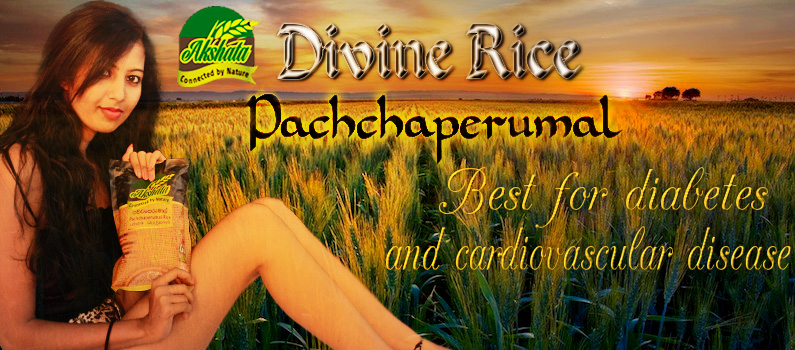The word ‘Pachchaperumal’ means The Lord ‘Buddha’s colour’ and has been considered divine rice in traditional Sinhalese culture. It was often used in alms giving’s. This is a wholesome red rice variety which when cooked takes on a deep rich burgundy colour. Rich in nutrients and in proteins, and is an excellent choice for your every day meal.
**Pachchaperumal Traditional Rice has one of the lowest glycemic index (GI), which averages less than 40 while the GI value of white rice is over 60!!! while the daily Bread you eat has over a 70 GI value…this means Pachchaperumal makes the blood glucose levels to rise the slowest from all rice & wheat varieties.
**Pachchaperumal has an Amylose Content of 27.7 !! which is one highest for any rice variety. Amylose is a type of resistant starch, meaning it isn’t well-digested and absorbed in the small intestine. Instead, it’s fermented by bacteria in the large intestine thereby limiting spikes in blood sugar levels and lowering cholesterol… this is why our forefathers and the Ayurveda community always recommended Pachchaperumal for Diabetics, now we have the science to prove they were right.
Now we know why it is called a divine rice, it certainly is a blessing.
Pachchaperumal rice is cholesterol free, and has no trans fats, sodium or gluten. The potassium, B vitamins and iron supplied are necessary nutrients. It has to be boiled a little longer than other varieties but the wait is worth it, once you get used to exquisite rich taste, there is no turning back.
The many Benefits of Pachchaperumal are listed below;
Additionally, the rice is a slow-release carbohydrate, which can help maintain blood sugar levels and keep energy consistent, according to Optimum Nutrition Therapy.
5. Cholesterol levels
Several studies have noted a possible relationship between brown rice varieties like Pachchaperumal and lowering bad cholesterol levels. A study published in the American Journal of Clinical Nutrition suggests that the oil in the rice plays an important role. This study looked at volunteers with moderately elevated cholesterol levels and concluded that the rice bran oil lowered their LDL (bad) cholesterol by 7 percent, while eating rice bran itself did not.
the rice’s good fiber content may also aid in lowering cholesterol levels. fiber aids in digestion, which requires bile acids, which are made partly with cholesterol. As your digestion improves, the liver pulls cholesterol from the blood to create more bile acid, thereby reducing the amount of LDL.
6. Cancer
the rice may help lower the risk of cancer thanks in part to its manganese. “Manganese may protect against free radicals, which are cancer-causing agents,” a British study published in the journal Cancer, Epidemiology, Biomarkers & Prevention analyzed the phenolic compounds in rice, brown rice bran and white rice for compounds associated with cancer suppression or reduction. Brown rice such as pachchaperumal and brown rice bran had much higher concentrations of the useful compounds than white rice.
the rice is particularly associated with lowered risk of colon cancer, prostate cancer and breast cancer. Brown rice is a good source of selenium, which may be associated with reduced risk of colon and prostate cancer. A large-scale study published in the International Journal of Cancer looked at the lifestyle, blood samples, and dietary practices of over half a million participants in 10 Western European countries and found that higher selenium levels were significantly associated with lower colon cancer risk.
7. Anti-inflammatory properties
Whole grains, including Pachchaperumal rice, have recently been shown to be as antioxidant-rich as many fruits and vegetables. Antioxidants are known to function as anti-inflammatories that can help with everything from arthritis to asthma, according to World’s Healthiest Foods.
this rice in particular has been linked with decreased inflammation.
8. Weight management
Plenty of fad diets tout the virtues of avoiding carbs, but brown/Red rice like Pachchaperumal shows it’s not that simple. This whole grain is a carbohydrate that, studies show, may actually help you lose weight or maintain a healthy weight. A study published in the American Journal of Clinical Nutrition studied over 70,000 American women free from serious illness for 12 years and found that “weight gain was inversely associated with the intake of high-fiber, whole-grain foods but positively related to the intake of refined-grain foods.” This reinforces the differences between refined grains like white rice and whole grains like brown rice.
Another study conducted in South Korea found that overweight women who replaced one meal a day with a mix of brown and black rice for six weeks lost more weight and showed an increase in good cholesterol and antioxidant activity than those who replaced one meal with white rice.
9. Metabolic syndrome risk reduction
A study published in Diabetes Care suggested that eating whole grains may help lower the risk of metabolic syndrome. Metabolic syndrome is a strong predictor of cardiovascular disease and Type 2 diabetes. Its symptoms include belly fat, low levels of good (HDL) cholesterol, high blood pressure and high triglycerides levels. The study followed more than 2,000 people for four years and found that metabolic syndrome was 38 percent lower in those who had high levels of whole grain fiber. On the other hand, those who had high glycemic indexes from eating refined foods were 141 percent more likely to develop metabolic syndrome.
10) The Miracle Nutrients of Pachchaperumal Rice


**this is a paid advertisement by http://grainsandgreen.com/

























Comments